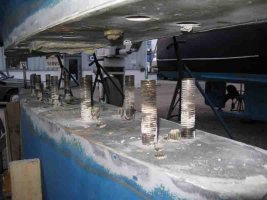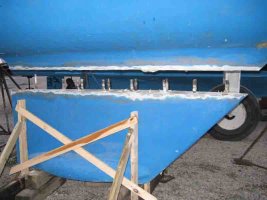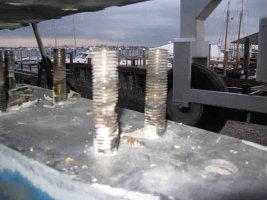Update:
Well, I used the super long hole saw today. It worked really well, too well in fact. I smoked my Makita 1/2" drill using it. I was able to saw down maybe 1"-1 1/4" before the saw would just slow/stop due to lack of power from the drill. I have a larger drill to try tomorrow. Anyone know the thickness of the keel stub floor? I am guessing 1 1/2" or so? I must be pretty close. The smell of the saw cutting and heating up the bedding compound is foul. I mean toxic make you gag foul. I have a headache after doing it so I think maybe it was not really healthy.
I am not overly concerned about widening the holes in the keel stub. The hole saw fit pretty tightly around the bolts so the clearance will likely end up 5/16" or so in total on each bolt. Additionally while using the saw it was quite apparent that the material being cut was not really fiberglass! I think the holes were bigger then we all think from the factory. Regarding the clearance, when reattaching the keel this area will fill with whatever bedding is used and then effectively locate the keel
The compound that was used to bed the keel is not like anything I have seen before. It turns to very dry coarse dust when cut with a sawzall. It appears like some sort of thickened resin as it has that mottled appearance as if it was thickened with chopped glass. It also kills the best sawzall blades available in minutes. Occasionally I get a whiff of polyester smell and sometimes sulfur so who knows! I've got a little experience with old 5200, etc. and this seems different. I don't think debonder will do anything as likely this is not 5200.
Regarding the question of dropping the keel or not. I had some concern after reading about some of the keel issues on this board. I also had a nice rust bleed on 3-4 keel bolts/washers. On the outside before I started messing with it there was visible parting line between the keel/hull forward and aft but not really in the middle. On the port side in the middle there was a one foot section of visible parting line and it had a rust colored tinge to it. Not a full blown bleed but rust nonetheless. Considering that 4-5 keel bolts have thread corrosion visible and the issues above existed I think that dropping the keel is the correct thing to do. Given the trouble I am having I think the keel would likely have been just fine for many more years. The problem is, how long until the issues I have found become failures? No way to know. The only way to know for sure is to drop it. So here I am.
I am at a bit of a loss at this point as I half expected the keel to loosen up a bit every time I have tried something new. I will return to the boat tomorrow and bring a more powerful drill to deepen the cuts until I hit lead. I am not sure I want to beat on the keel bolts with a sledgehammer. I am worried that they may just compress in the lead or bend to the side. 304 stainless is relatively soft. After deepening the saw cuts I am going to try oak wedges hammered into the crack fore and aft.
If anyone has any other ideas I'd love to hear them

RT
ps-Don, yes thats a Blade CP tailrotor. Had I taken that shot from the other direction you would have seen a eCCPM conversion ARK X400.... I can't do much other than hover but its fun!

 RT
RT

